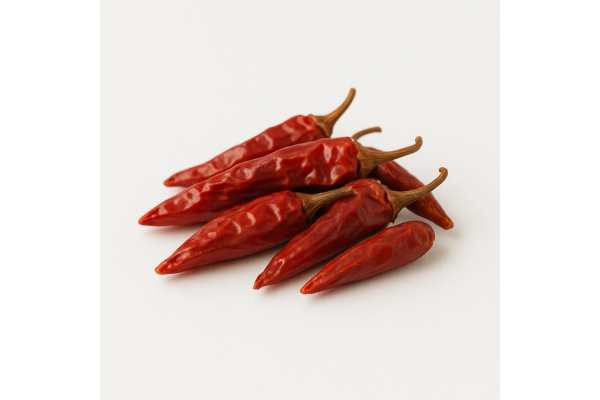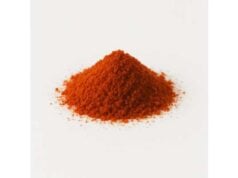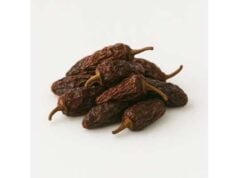
Chili peppers bring heat, color, and aroma to dishes around the world, but they are more than a culinary thrill. They provide vitamins, antioxidants, and unique bioactive compounds, especially capsaicin, which has been studied for effects on metabolism, cardiovascular health, and pain perception. At the same time, spicy foods do not suit everyone, and high intakes can be uncomfortable or even risky for some people.
This guide walks you through what chili peppers actually do in the body, how much is reasonable to eat, who may benefit the most, and who needs to be cautious. You will also find practical advice on choosing fresh and dried peppers, storing them safely, and cooking them in ways that preserve nutrients while keeping the heat manageable. The aim is not to convince you to eat very spicy food, but to help you use chili peppers thoughtfully as part of an overall healthy pattern of eating.
Chili Pepper Fast Facts
- Typical culinary portion is about 2–5 g fresh chili (or 0.5–1 g chili powder) per meal, up to several times per week for most healthy adults.
- Chili peppers are low in calories and rich in vitamin C, carotenoids, and capsaicin, which may modestly support metabolic and cardiovascular health.
- People with gastroesophageal reflux, peptic ulcer disease, irritable bowel syndrome, or hemorrhoids often need to limit spicy foods.
- Very high capsaicin intakes from extreme hot sauces, extracts, or eating challenges can cause severe pain, vomiting, and cardiovascular symptoms, especially in children.
- Those taking certain gastrointestinal or cardiovascular medicines, or with chronic digestive conditions, should discuss regular high-chili diets with a healthcare professional.
Table of Contents
- Chili pepper detailed overview
- Chili pepper nutrition and compounds
- Health benefits of chili pepper
- Risks, allergies and interactions
- Selecting and storing chili peppers
- Cooking chili peppers for nutrition
- Portions, comparisons and chili FAQs
Chili pepper detailed overview
Chili peppers are the fruits of plants in the Capsicum genus, part of the nightshade family that also includes tomatoes and bell peppers. They originated in the Americas and spread globally after the 15th century, becoming central to cuisines from Mexico and Peru to India, Thailand, Korea, and beyond. Today, they appear fresh, dried, smoked, fermented, and ground into powders or pastes.
Their defining characteristic is pungency, or “heat,” driven mainly by capsaicinoids, especially capsaicin. The Scoville Heat Unit (SHU) scale is used to estimate this heat: mild jalapeños may measure 2,500–8,000 SHU, while some specialty varieties and extracts reach over a million SHU. In everyday cooking, most people use mild to moderately hot peppers and adjust the amount rather than chasing extremes.
Chili peppers vary widely in shape, color, and flavor. Fresh varieties include:
- Mild to moderate: Anaheim, poblano, fresno.
- Medium to hot: jalapeño, serrano, Thai bird’s eye.
- Very hot: habanero, Scotch bonnet, ghost pepper, and other “super-hot” cultivars.
Processing changes both flavor and health properties. Drying concentrates capsaicinoids and other compounds, so one teaspoon of chili powder can be far “stronger” than a small piece of fresh pepper. Smoking (as in chipotle) adds complex aromas but may introduce small amounts of smoke-related compounds. Fermenting chilies into sauces or pastes can influence their acidity, microbial profile, and gentle probiotic potential.
From a culinary standpoint, chili peppers do more than burn. Used in moderate quantities, they can:
- Enhance perception of sweetness and umami in a dish.
- Balance rich or fatty foods, such as stews and grilled meats.
- Add bright color, especially in red and orange varieties rich in carotenoids.
In traditional medicine systems, chili peppers have long been used for appetite stimulation, warming the body in cold weather, and easing joint or muscle discomfort. Modern research has started to explore these uses more systematically, particularly through the lens of capsaicin’s effects on sensory nerves, blood vessels, and metabolic regulation.
Understanding chili peppers begins with acknowledging this dual nature: they are both a pleasurable flavoring and a potent source of bioactive molecules. The same compound that makes a curry satisfying can cause discomfort at higher doses, especially in sensitive people. The rest of this guide will help you navigate that balance.
Chili pepper nutrition and compounds
Fresh chili peppers are surprisingly low in calories while offering a dense package of micronutrients and phytochemicals. A typical 100 g serving of raw red chili peppers (more than most people eat at once) provides roughly:
- Around 40 kcal.
- Mostly water, with modest carbohydrate and a small amount of fiber.
- Significant vitamin C (often several times the daily requirement).
- Provitamin A (from carotenoids such as beta-carotene and capsanthin).
- Vitamin B6, vitamin K1, potassium, and small amounts of other minerals.
A more typical culinary portion is much smaller: about 2–5 g of fresh chili in a dish or 0.5–1 g of chili powder. Even at these amounts, chili can notably contribute vitamin C and antioxidant pigments, especially when eaten regularly.
The key bioactive groups in chili peppers include:
- Capsaicinoids:
- Capsaicin and dihydrocapsaicin are the primary contributors to heat.
- They activate TRPV1 receptors on sensory neurons, which signal heat and pain but also influence metabolic and vascular responses.
- Concentrations are highest in the white inner membranes (placenta) and surrounding tissue, with lower levels in the seeds and flesh.
- Carotenoids:
- Red and orange chilies contain pigments such as capsanthin, capsorubin, and beta-carotene.
- These compounds act as antioxidants and are fat-soluble, meaning absorption improves when chili is eaten with dietary fat.
- Polyphenols and flavonoids:
- Chili peppers contain phenolic acids and flavonoids that contribute additional antioxidant and anti-inflammatory effects.
- The total content depends on variety, ripeness, and growing conditions.
- Other components:
- Small amounts of fiber, particularly in dried chilies.
- Minor alkaloids and volatile aroma compounds that shape flavor beyond simple heat.
Nutrient density also depends on processing:
- Fresh chilies retain vitamin C and many heat-sensitive compounds when lightly cooked or used raw.
- Drying reduces vitamin C but concentrates carotenoids and capsaicinoids. A teaspoon of high-quality chili powder can be a dense source of these compounds.
- Pickling and fermenting may diminish some vitamins but can improve shelf life, add acidity, and slightly modify bioactive profiles.
Different colors often signal different dominant pigments. Green chilies are unripe and tend to contain more chlorophyll and somewhat lower carotenoid levels; red chilies are fully ripe and richer in carotenoids and often vitamin C. However, heat level (how spicy the pepper feels) is more related to cultivar and capsaicinoid content than color alone.
From a nutritional standpoint, chili peppers are best thought of as a “high-impact seasoning” rather than a bulk vegetable. They bring powerful bioactive compounds and important vitamins in small doses. Because the spicy sensation naturally limits how much most people can tolerate, you rarely obtain large amounts of energy from chili, but you may still receive meaningful amounts of protective phytochemicals.
Health benefits of chili pepper
Research on chili peppers and health has grown rapidly in recent years, focusing on both whole-food intake and isolated capsaicin. While the evidence is still evolving and not every study agrees, several themes emerge.
1. Cardiovascular and longevity signals
Large observational studies in different populations have linked regular chili pepper consumption with lower risks of overall mortality and deaths from cardiovascular causes. People who eat chili-containing foods several times per week tend, on average, to have fewer fatal heart and stroke events than those who rarely eat spicy food, even after adjusting for many lifestyle factors.
These findings do not prove that chili peppers alone cause longer life, but they suggest that moderate, regular consumption may be one marker of dietary patterns that support cardiovascular health. Proposed mechanisms include:
- Modest improvements in blood lipids in some trials of capsaicin or chili-based products.
- Effects on blood vessel function and blood pressure regulation through TRPV1 activation.
- Anti-inflammatory and antioxidant actions of capsaicin and carotenoids.
2. Metabolic effects and weight management
Capsaicin is often marketed as a “fat-burning” ingredient. Controlled studies show a more modest but still interesting picture:
- Capsaicin and related compounds can increase energy expenditure slightly and may shift the body toward burning more fat for a short period after intake.
- Some trials find a small reduction in appetite or caloric intake when people consume capsaicin-containing foods or supplements, particularly in those not accustomed to spicy food.
- Meta-analyses of overweight and obese participants suggest that capsaicin supplementation may produce small reductions in body weight, waist circumference, or cholesterol in the context of broader lifestyle changes.
Overall, chili peppers and capsaicin may support weight management by slightly boosting thermogenesis and appetite control, but they are not a substitute for foundational habits like balanced eating, movement, and adequate sleep.
3. Glucose control and metabolic syndrome
Experimental and clinical studies suggest that capsaicin may influence insulin sensitivity, glucose tolerance, and lipid metabolism:
- In some trials, capsaicin supplementation improves insulin sensitivity or reduces fasting blood glucose, particularly in people with metabolic syndrome.
- Regular intake may modestly lower total and LDL cholesterol in specific groups.
- Emerging work on the gut microbiome indicates that capsaicin can shift microbial populations and bile acid metabolism, which may play a role in metabolic and inflammatory regulation.
However, the size of these effects varies; some well-designed studies observe minimal or no benefit. As a result, chili peppers are best seen as a potentially helpful addition to a metabolic health strategy, not a stand-alone treatment.
4. Pain and nerve-related benefits (mostly topical)
Topical capsaicin creams and patches are widely used for neuropathic pain, such as diabetic nerve pain and post-herpetic neuralgia. High-concentration patches, applied under medical supervision, can provide significant pain relief for weeks by desensitizing TRPV1-expressing nerve fibers.
While this use does not rely on eating chili peppers, it underscores the biological potency of capsaicin and helps explain why even small dietary amounts can have noticeable systemic effects in some individuals.
5. Potential neuroprotective and anti-inflammatory roles
Animal and cellular models suggest that capsaicin may:
- Reduce certain inflammatory pathways.
- Influence brain circuits involved in cognition and neurodegenerative diseases.
- Modulate oxidative stress and cell signaling in ways that could be protective.
Human data in these areas remain limited and preliminary. For now, chili peppers can reasonably be considered part of an antioxidant- and phytochemical-rich diet that may support long-term brain and cardiovascular health, but claims of strong protective effects should be viewed cautiously.
Taken together, the health story of chili peppers is one of small to moderate potential benefits at typical culinary doses, with stronger but still not fully decisive evidence in specific areas like cardiovascular outcomes and lipid profiles. Benefits appear to plateau and may reverse at very high intakes, especially when spicy foods are consumed in extreme forms.
Risks, allergies and interactions
Despite their potential advantages, chili peppers are not risk-free. Individual tolerance varies widely, and some people experience significant discomfort even with modest amounts. Understanding the main risk categories can help you decide what level of intake is appropriate.
1. Gastrointestinal symptoms
The most common adverse effects are related to the digestive tract:
- Burning or pain in the mouth, throat, or stomach.
- Heartburn and acid reflux, particularly in people with gastroesophageal reflux disease (GERD).
- Worsening of pre-existing gastritis or peptic ulcers in some individuals.
- Abdominal cramping, diarrhea, or painful bowel movements, which may aggravate irritable bowel syndrome (IBS) or hemorrhoids.
Not everyone with these conditions reacts the same way. Some people report that moderate, regular intake actually reduces discomfort over time, while others find even small amounts intolerable. A gradual approach and careful self-observation are essential.
2. High-dose capsaicin exposure
Problems become more serious when capsaicin intake is very high, such as:
- Participating in chili-eating contests or trying “extreme” hot sauces and extracts.
- Consuming products heavily fortified with capsaicin or capsaicinoid concentrates.
Reports describe severe burning pain, vomiting, chest pain, faintness, and changes in blood pressure after consumption of extremely hot products. Risk may be higher in people with underlying heart disease, in children, and in those unaccustomed to spicy foods.
Regulatory reviews highlight that even doses in the low milligram range can cause mild symptoms like warmth or heartburn in sensitive individuals, while very high doses—hundreds of milligrams at once—have been associated with pronounced adverse effects such as intense gastrointestinal pain and circulatory symptoms. Because labeling of capsaicin content is often inconsistent, it can be easy to underestimate the dose when using ultra-hot sauces or extracts.
3. Skin, eye, and respiratory irritation
Handling hot chili peppers releases capsaicin onto the skin and into the air. Typical issues include:
- Burning sensations on the hands or face, especially if you rub your eyes.
- Eye redness, tearing, and temporary vision discomfort from accidental contact.
- Coughing, throat irritation, or a feeling of chest tightness when inhaling aerosolized capsaicin while cooking or grinding dried chilies.
Wearing gloves, avoiding touching your face, and washing hands thoroughly with soap (or using an oil-based cleanser or dairy product to help dissolve capsaicin) are simple but effective precautions. Never handle contact lenses after chopping chilies without washing your hands thoroughly.
4. Allergic reactions and sensitivities
True allergy to chili peppers is relatively rare but can occur. Signs may include:
- Itching or swelling of the lips, mouth, or throat unrelated to simple “spice burn.”
- Hives or generalized skin rash.
- Wheezing, breathing difficulty, or systemic symptoms after eating chili-containing dishes.
Anyone experiencing these should seek medical care promptly and avoid further exposure until evaluated. Cross-reactivity with other nightshades or certain pollens is possible but not universal.
5. Interactions and specific populations
Chili peppers and capsaicin can interact indirectly with medications or medical conditions, for example:
- People with established heart disease, uncontrolled hypertension, or arrhythmias may be more vulnerable to blood pressure or heart rate fluctuations during extreme spicy challenges.
- Those taking drugs that irritate the stomach (such as certain pain relievers) may find that spicy food further aggravates symptoms.
- Children are more likely to experience pronounced discomfort or toxicity at lower absolute doses and should not be given extremely hot products.
Pregnant and breastfeeding individuals can usually enjoy moderate amounts of chili if tolerated, but very spicy meals may worsen reflux or nausea. Infants and very young children should not be given highly spicy foods, mainly due to discomfort and feeding aversion rather than proven toxicity at normal household doses.
If you have chronic gastrointestinal disease, cardiovascular conditions, or complex medication regimens, it is sensible to discuss your typical chili intake with a healthcare professional, especially if you are considering supplements or very spicy products.
Selecting and storing chili peppers
Choosing high-quality chili peppers and storing them correctly helps preserve flavor, nutrients, and safety. This applies whether you use mild, medium, or very hot varieties.
Selecting fresh chili peppers
When buying fresh chilies:
- Look for firm, smooth skins without soft spots, wrinkles, or dark moldy patches.
- Colors should be vibrant: bright green, yellow, orange, or red depending on the variety and ripeness.
- Stems should be green and not dried or blackened.
- For milder heat, choose larger, thicker-fleshed chilies; smaller, thinner peppers often pack more capsaicin.
If possible, buy peppers that have been stored cool and away from direct sunlight. Local and seasonal chilies may offer better flavor and environmental footprints due to shorter transport distances.
Selecting dried chilies and chili powder
Drying intensifies flavor and capsaicin concentration, so quality is important:
- Whole dried chilies should be pliable rather than brittle and should not smell musty.
- Avoid products with visible mold, insect damage, or signs of excessive dust.
- For chili powders and ground blends, choose reputable brands with clear labeling and sealed packaging; exposure to air and light accelerates loss of aroma and pigments.
Smoked chilies and powders provide complex flavors but may contain small amounts of smoke-derived compounds. Occasional use in home cooking is generally considered acceptable; for frequent consumption, balance them with non-smoked chili forms.
Storage for safety and quality
Fresh chilies:
- Store in the refrigerator, ideally in the crisper drawer, in a breathable bag or container.
- Most varieties keep well for about 1–2 weeks if dry and not overcrowded.
- Do not wash before storage; excess moisture encourages mold. Rinse just before use.
Dried chilies and chili powders:
- Keep in airtight containers in a cool, dark place away from direct sunlight and heat sources.
- Use within 6–12 months for best flavor, though they may remain safe longer if dry and mold-free.
- If you live in a humid climate, consider storing dried chilies in the refrigerator or freezer to reduce the risk of spoilage.
Freezing is an excellent way to extend the life of fresh chilies. You can freeze them whole or sliced in small portions; they will lose some crispness but keep their heat and many flavor compounds. This is particularly useful if you buy in bulk or harvest from a home garden.
Sustainability and ethical considerations
On a broader level, sustainability around chili peppers involves:
- Choosing suppliers that use fair labor practices, especially for very hot varieties where field workers may be exposed to high capsaicin levels during harvesting and processing.
- Reducing food waste by freezing or drying surplus chilies rather than discarding them.
- Supporting local or regional producers when possible, which may lower transport-related emissions.
These steps help ensure that chili peppers fit not only into a personal health strategy, but also into a responsible approach to food systems and the environment.
Cooking chili peppers for nutrition
How you prepare chili peppers has a strong influence on both their health effects and how enjoyable they are. A few careful choices can preserve vitamins and enhance absorption of helpful compounds while keeping heat at a comfortable level.
Heat, nutrients, and cooking methods
- Vitamin C: very sensitive to heat and prolonged cooking. Raw chilies, quick stir-fries, and late-in-the-pan additions preserve more of this vitamin than long-simmered dishes.
- Carotenoids and capsaicinoids: more heat-stable and fat-soluble. Sautéing or simmering chilies in a small amount of oil can actually improve absorption of these compounds.
- Fermented and pickled chilies: may lose some vitamin C but gain acidity and flavor complexity; certain beneficial microbial metabolites can appear during fermentation.
From a nutrition perspective, a practical approach is to use a mix of preparations:
- Add a small amount of fresh chili at the end of cooking or as a garnish to retain vitamin C.
- Use cooked chilies in stews, curries, and sauces to take advantage of better carotenoid and capsaicin absorption.
Controlling heat while cooking
If you enjoy flavor but not intense burning:
- Remove the inner white membranes (and seeds attached to them), which contain much of the capsaicin.
- Start with mild varieties and gradually experiment with hotter ones as your tolerance allows.
- Add chili early in cooking to allow capsaicin to disperse, which may make the heat feel more integrated and slightly less sharp.
- Balance heat with acidity (lime, lemon, vinegar), sweetness (tomatoes, roasted vegetables), and fat (yogurt, coconut milk, olive oil).
Conversely, if you want more heat without much volume of chili:
- Use hotter varieties or dried chili flakes and powders, which are more concentrated.
- Toast whole dried chilies briefly in a dry pan before blending to deepen flavor, taking care not to burn them.
Safety in the kitchen
- Wear disposable gloves when handling hot peppers, especially super-hot varieties.
- Use a dedicated cutting board and knife if you cook for people who cannot tolerate chili, to avoid cross-contamination.
- Ventilate the kitchen well when searing or frying chilies; aerosolized capsaicin can cause coughing and eye irritation.
If you accidentally overheat a dish:
- Dilute with additional base ingredients (vegetables, grains, or protein) rather than just adding water.
- Serve with cooling sides such as yogurt, raita, avocado, or plain rice.
- Encourage diners to drink milk or yogurt-based beverages rather than water; fat and casein help dissolve and buffer capsaicin.
Nutrient retention and cultural dishes
Many traditional dishes already use techniques that balance flavor and nutrition:
- Quick stir-fries with sliced chilies and vegetables preserve crunch and vitamins.
- Stews and curries often combine chilies with spices, aromatics, and fats, enhancing the absorption of fat-soluble phytochemicals.
- Fresh relishes and salsas provide raw chili along with herbs and citrus, supporting both taste and micronutrient intake.
Using these patterns as templates, you can adapt chili pepper use to your own preferences and tolerances while maintaining or even enhancing their nutritional value.
Portions, comparisons and chili FAQs
Questions about “how much is safe,” “which form is best,” and “who should avoid chili” are among the most common. This section brings the main points together in a practical way.
Reasonable portions and frequency
For generally healthy adults with no significant gastrointestinal or cardiovascular conditions:
- A typical culinary serving is 2–5 g of fresh chili (roughly ½–1 small chili) per meal, or 0.5–1 g of chili powder.
- Many people can comfortably include chili-containing dishes 2–4 times per week, and some cultures traditionally eat them daily.
- If you are new to spicy foods, start with smaller amounts once or twice per week and increase gradually only if you feel well.
Remember that tolerance varies. Some individuals routinely consume much more without issues; others experience discomfort at lower levels. Let symptoms guide you rather than chasing a specific “target dose.”
Who should limit or avoid chili peppers?
It is sensible to limit or avoid chili peppers if you:
- Have active peptic ulcers, severe reflux, or inflammatory bowel disease that worsens with spicy food.
- Experience significant pain, diarrhea, or rectal burning after modest chili intake.
- Have a history of allergic reactions to peppers or other nightshades.
- Are a child, especially under school age, where the risk of severe discomfort is higher and communication about symptoms may be limited.
- Are advised by your doctor to avoid spicy foods due to specific heart, gastrointestinal, or postoperative conditions.
In these cases, focusing on non-spicy vegetables and fruits with similar nutrients (such as bell peppers for vitamin C and carotenoids) is usually a better choice.
Chili peppers vs. chili supplements
Capsaicin supplements and highly concentrated extracts are sometimes promoted for weight loss, pain relief, or metabolic health. While they can deliver standardized doses, they also:
- Increase the risk of gastrointestinal intolerance and high-dose exposure.
- Lack the broader nutritional matrix of whole peppers, such as fiber and diverse phytochemicals.
- May interact with medications or underlying conditions more strongly than ordinary food use.
For most people, obtaining capsaicin and related compounds from culinary chili peppers is safer and adequate. Supplements should only be used after discussing potential risks and benefits with a qualified health professional.
Comparisons with non-spicy peppers and other spices
- Bell peppers (sweet peppers): very similar botanically but lacking capsaicin. They provide vitamin C and carotenoids without heat and are an excellent option for those who cannot tolerate spicy foods.
- Cayenne and paprika: typically ground forms of specific chili varieties. Cayenne is usually hot, while paprika ranges from sweet to smoky and mild. Their nutritional profiles resemble chili pepper powder, though exact contents depend on processing.
- Other pungent spices (black pepper, ginger, mustard): produce heat through different compounds and mechanisms. People intolerant of chili may or may not tolerate these; reactions are individual.
Common FAQs
- Do chili peppers “burn fat”?
They can modestly increase energy expenditure and may help reduce appetite in some people, but the effect size is small. They should be viewed as a supportive element within a broader lifestyle, not a stand-alone fat-loss tool. - Do they cause ulcers?
In moderate amounts, chili peppers do not universally cause ulcers and may even have protective effects in some contexts. However, they can aggravate existing ulcers or gastritis in sensitive individuals. - Are chili peppers safe during pregnancy?
For most pregnant individuals who already eat spicy food, moderate continued use is acceptable if it does not worsen reflux or nausea. Extreme spicy challenges are not advisable due to discomfort and stress responses. - Is it possible to “build tolerance”?
Yes, many people find that repeated, gradual exposure reduces the perceived intensity of chili heat. However, underlying conditions such as severe reflux or IBS may still limit safe intake.
Used thoughtfully, chili peppers can be part of a varied, enjoyable diet that supports health. The key is matching the type and amount of chili to your body’s responses rather than following a single universal rule.
References
- Spicy Food and Chili Peppers and Multiple Health Outcomes: Umbrella Review 2022 (Systematic Review)
- Chili Pepper Consumption and Mortality in Italian Adults – PubMed 2019 (Cohort Study)
- Dietary Capsaicin: A Spicy Way to Improve Cardio-Metabolic Health? 2022 (Review)
- Lipid-Lowering Efficacy of the Capsaicin in Patients With Metabolic Syndrome: A Systematic Review and Meta-Analysis of Randomized Controlled Trials 2022 (Systematic Review)
- High capsaicin levels can harbour health risks 2024 (Risk Assessment)
Disclaimer
The information in this article is intended for general educational purposes and does not replace individual medical advice, diagnosis, or treatment. Chili pepper intake can affect people differently, especially those with gastrointestinal, cardiovascular, metabolic, or allergic conditions. Always consult a qualified healthcare professional before making significant changes to your diet, using capsaicin-containing supplements, or if you experience concerning symptoms after consuming spicy foods. Never ignore or delay seeking professional medical advice because of something you have read here.
If you found this article useful, you are warmly encouraged to share it with others on Facebook, X (formerly Twitter), or any platform you prefer. Thoughtful sharing helps more readers access reliable nutrition information and supports the ongoing work required to produce evidence-based content like this.










